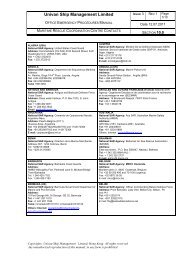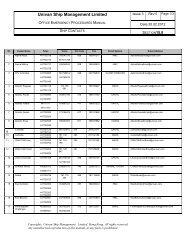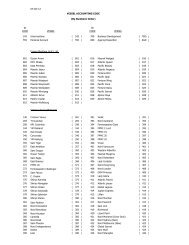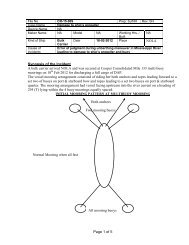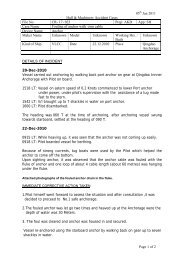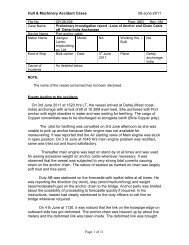Section: 11 CARGO OPERATIONS - Univan
Section: 11 CARGO OPERATIONS - Univan
Section: 11 CARGO OPERATIONS - Univan
You also want an ePaper? Increase the reach of your titles
YUMPU automatically turns print PDFs into web optimized ePapers that Google loves.
<strong>Univan</strong> Ship Management Limited Issue 1 REV 0 Page<br />
1/4<br />
FLEET OPERATION MANUAL Date 01.01.2005<br />
<strong>11</strong>.2 Major safety Concerns<br />
MAJOR SAFETY CONCERN<br />
SECTION <strong>11</strong>.2<br />
Ro-Ro Cargo Carriers have their own peculiarities, and these special characteristics are very<br />
different from the other vessels. This makes these Ro-Ro Cargo Carriers as very special vessels.<br />
And we need to understand what these peculiarities are and how they affect the vessel operation.<br />
Hereunder we are giving you a list of these special characteristics, so that you keep bringing<br />
them into your consideration while operating this kind of vessels:<br />
<strong>11</strong>.2.1 External ramps<br />
The vessels are fitted with external ramps. These are the large openings to give access<br />
to cargo compartment for the purpose that roll on and off cargo may easily be loaded.<br />
Imagine now on a dry bulk carrier we have detailed procedures and precautions to avoid<br />
any ingress of water from cargo hatches.<br />
Remember now those hatches are horizontal and on weather deck, and in case of Ro-Ro<br />
Cargo Carriers ramps are vertical and on the ship side.<br />
We leave it to your imagination how many times more careful you should be while<br />
operating external ramps for water tightness.<br />
<strong>11</strong>.2.2 Connectivity of all the cargo compartments<br />
For the accessibility of all the cargo spaces they should be approachable to external<br />
ramps through the adjoining cargo spaces. Well, this means, the complete cargo area is<br />
exposed to seawater ingress, in the event of flooding of any one part of cargo space.<br />
Also the fire may spread to all adjoining cargo spaces as all the cargo space are<br />
interconnected, if fire doors are not closed.<br />
Vessel is divided into individual fire zones, and these fire zones can be isolated from<br />
each other by gas tight doors.<br />
But what if the fire breaks out during the cargo operation when the these gas tight doors<br />
are open for accessibility of cargo, and now these gas tight doors can not be reached for<br />
closing.<br />
This is also unlike of other ships where one cargo compartment does not have access<br />
from the other compartments.<br />
<strong>11</strong>.2.3 Large cargo volume with respect to deadweight assigned<br />
This is also an inherent characteristic of a car carrier. Before understanding what is so<br />
important with this characteristic, please go through a vessel’s particulars of a 2528 unit<br />
Ro-Ro Cargo Carriers, which are given hereunder.<br />
Lightship = 7383 MT<br />
Deadweight = 9358 MT<br />
Gross Registered Tonnage = 27013<br />
Length between perpendiculars = 148M<br />
Breadth molded = 27.8 M<br />
Summer draft = 9.358M<br />
Engine Power= 9450 SHP<br />
These figures may surprise some of you, who have not been working on this kind of ship.<br />
On an average on other cargo vessels light ship is about 25% of summer deadweight and<br />
GRT is about 45% of summer deadweight.<br />
And in the case of PCC vessels, we have lightship almost equal to deadweight and GRT<br />
is 3 times the deadweight.<br />
So this is clear these vessels that these vessels have low deadweight assigned to their<br />
lightship. We can also say that they have low volume below the summer draft.<br />
In other words they have low under water volumes even in loaded conditions, if we<br />
Copyrights: <strong>Univan</strong> Ship Management Limited, Hong Kong. All rights reserved<br />
Any unauthorized reproduction of this manual, in any form is prohibited



